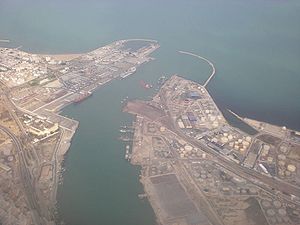Radès
| Radès | |
|---|---|

Radès harbor
|
|
| Location in Tunisia | |
| Coordinates: 36°46′N 10°17′E / 36.767°N 10.283°E | |
| Country |
|
| Elevation | 160 ft (50 m) |
| Population (2014) | |
| • Total | 59,998 |
| • Ethnicities | Arab |
| • Religions | Islam |
| Time zone | CET (UTC1) |
| Postal code | 2040 |
Radès (Arabic: رادس) is a harbour city in Ben Arous Governorate, Tunisia. Situated 9 kilometres south-east of the capital Tunis, some consider it a Tunis suburb, and parts of the harbour installations of Tunis are located in Radès.
Rades is divided into subcities: Radès Medina, Radès Méliane, Rades Forêt, Chouchet Radès, El Malleha, Noubou and The Olympic city, Farhat Hached High School.
Maxula Prates was a town of the Roman Province of Africa.
Radès derives its name from the Latin expression Maxula per races (Maxula by the ferries ), Maxula being the original Libyco-Berber name of the village near which is in the Antiquity a station of boats whose function is To connect the terminus of the coastal road with Carthage by sea. The Arabs have retained from this toponymic designation only spleens which they have transformed into Rades (ref. Required] .
From the beginning of the Muslim conquest of the Maghreb , the hill of Rades was equipped with a ribat. It is around this ribat, which has long since disappeared, that the village of which it is spoken in the 11th century was built and which seems to have been provided with a port since that time. Under the Hafsides , vinyards spread over the hillsides
During the reign of the Husseinite beys , Radès was inhabited by farmers and sought by the notables of Tunis city. The locality then grew rapidly and extended to the beach and the surrounding hills during the 19th century. High dignitaries built houses such as houses in a Hispano-Arabic style decorated with gardens such as those of governor Mokhtar Ben Zid and brigadier general Allala Ben Frija, who built a house there in 1862.
Between the end of the 19th and the beginning of the 20th century , members of the Djellouli family built themselves beautiful houses of Hispano-Arabic style, notably the ministers M'hammed Djellouli and Taïeb Djellouli , as well as the Governor Sadok Djellouli. French residents also built bourgeois villas in Europe. One can quote the colonial villa built in 1905 and bought by the Grand Vizier M'hamed Chenik , which gives it Hispano-Moorish and Italian styles; His brother Hassen, a notable landowner, lived in the villa Vacherot, which became his residence in the middle of the 20th century.
...
Wikipedia

